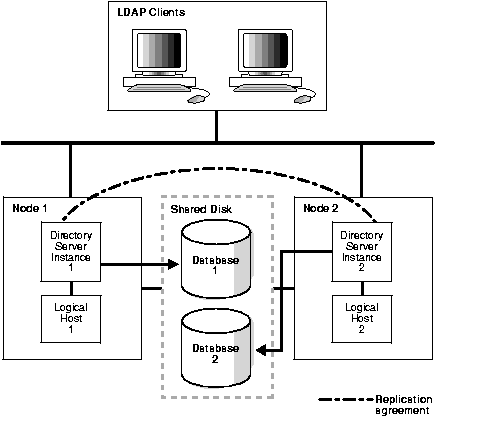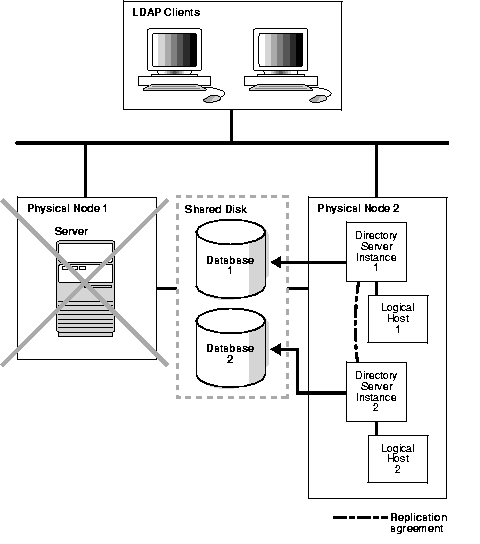Release 9.2
Part Number A96574-01
Home |
Book List |
Contents |
Index |
 Master Index |
 Feedback |
| Oracle Internet Directory Administrator's Guide Release 9.2 Part Number A96574-01 |
|
This chapter contains these topics:
Oracle Internet Directory Release 9.2 enables you to increase high availability by using logical hosts--as opposed to physical hosts--in clustered environments.
A logical host consists of one or more disk groups, and pairs of host names and IP addresses. It is mapped to a physical host in the cluster. This physical host impersonates the host name and IP address of the logical host.
In this paradigm, the directory server binds to the logical host, rather than the physical host. It maintains this connection even if the logical host fails over to a new physical host.
A client connects to the directory server by using the logical host name and address of the server. If the logical host fails over to a new physical host, then that failover is transparent to the client.
A logical host can reside on two or more cluster nodes that have physical access to its disk storage. A cluster can typically support any number of logical hosts, and a physical server or cluster node can impersonate more than one logical host.
This failover mechanism also supports replicated environments.
Figure 24-1 shows a sample Oracle Internet Directory configuration on a hardware cluster.

In this configuration:
Clients connect to Directory Server Instance 1 by using the host name and address of Logical Host 1. Similarly, clients connect to Directory Server Instance 2 by using the host name and address of Logical Host 2.
This section tells you how to configure failover in a clustered environment.
It contains these topics:
When you start OID Monitor, use the optional host argument, and set it to the logical host name. In the following example, OID Monitor connects to the directory store, my_net_service and monitors the directory server instances on the logical host, my_host.:
oidmon [connect=my_net_service] host=my_host
When you start the directory server by using the OID Control utility, use either of the optional flags -host or -h, and set it to the logical host name. In the following example, the OID Control utility directs the OID Monitor to start the directory server instance on the logical host, my_host.
oidctl connect=my_net_service server=oidldapd instance=1 flags="-h my_host"
start
Similarly, when you start a directory replication server by using the OID Control utility, use either of the optional flags -host or -h, and set it to the logical host name. In the following example, the OID Control utility directs the OID Monitor to start the directory replication server on the logical host, my_host.
oidctl connect=my_net_service server==oidrepld instance=1 flags="-h my_host"
start
To run Oracle Internet Directory on a logical host, stop the directory server instance and the OID Monitor, then restart them by using either of the optional flags -host or -h. Do this before any updates are made to the directory. This way, you ensure that the directory server uses the logical host name in change log generation.
Figure 24-2 shows a scenario in which a failover has occurred and the directory server has been restarted.

In Figure 24-2, Physical Node 1 fails. At that point, Logical Host 1 fails over to be mastered by Physical Node 2. After this has finished, Directory Server Instance 1 needs to be restarted--that is, OID Monitor needs to be restarted with Logical Host 1 specified as the host name.
This failover of Directory Server Instance 1 is transparent to the LDAP clients connecting to Directory Server Instance 1. These clients continue to connect to Directory Server Instance 1 by using the host name and address of Logical Host 1.
After the failover, Directory Server Instance 1 continues to use the host name of Logical Host 1 in the change log generation. The replication agreement between Directory Server Instance 1 and Directory Server Instance 2 continues as before the failover.
|
 Copyright © 1999, 2002 Oracle Corporation. All Rights Reserved. |
|